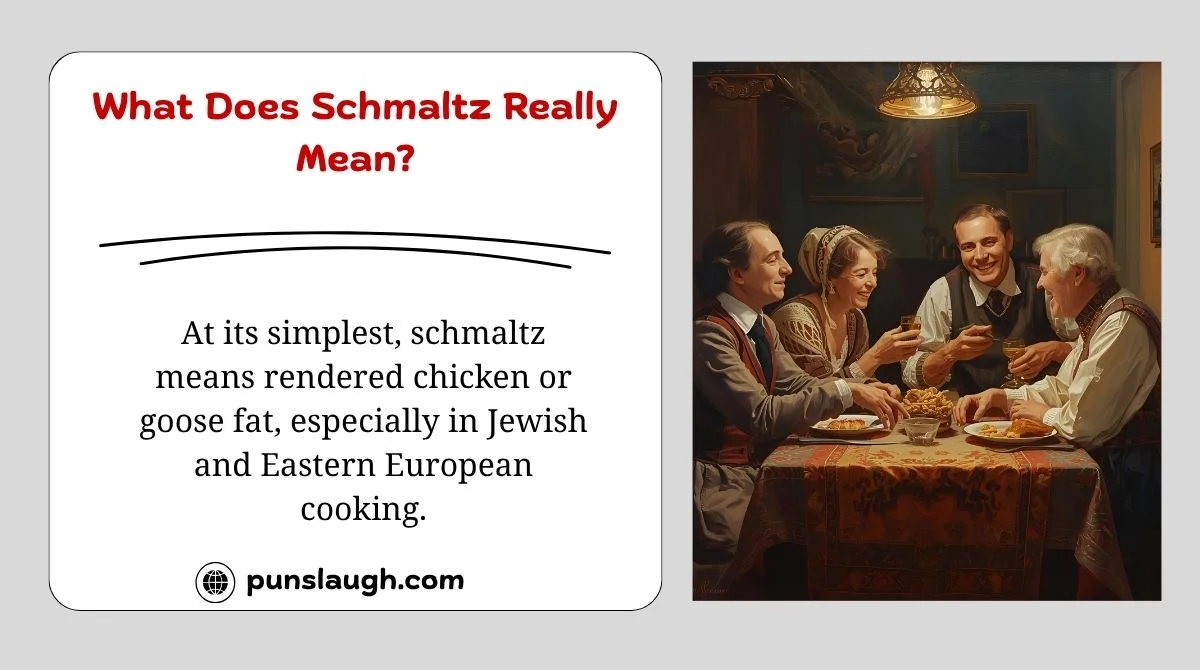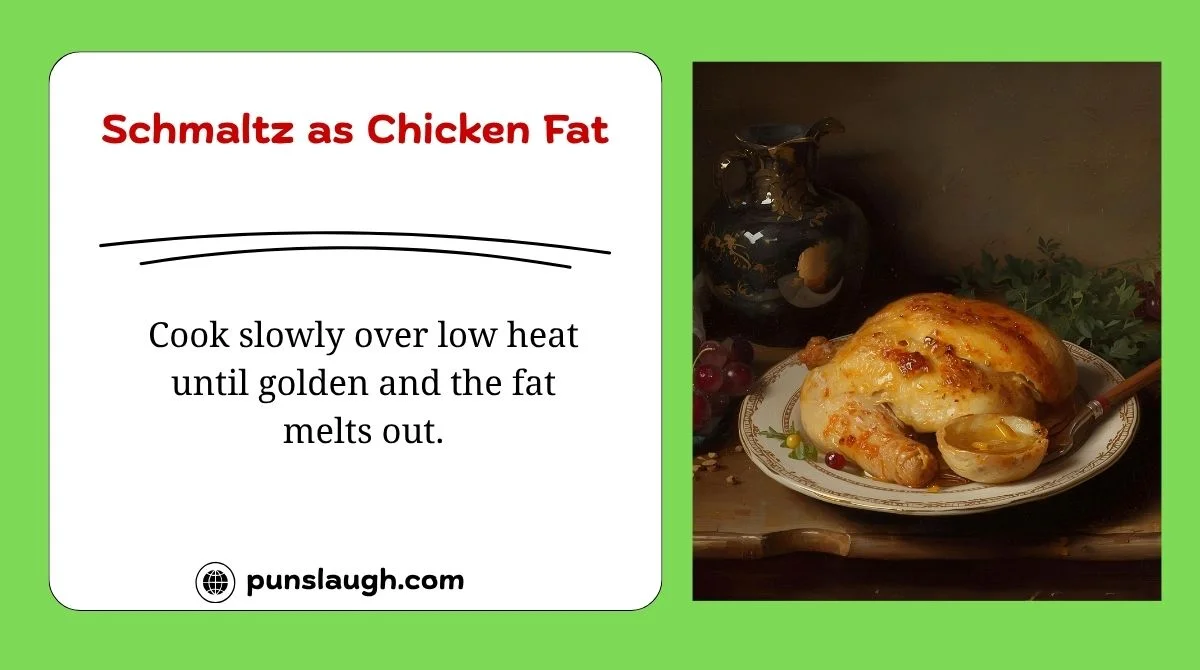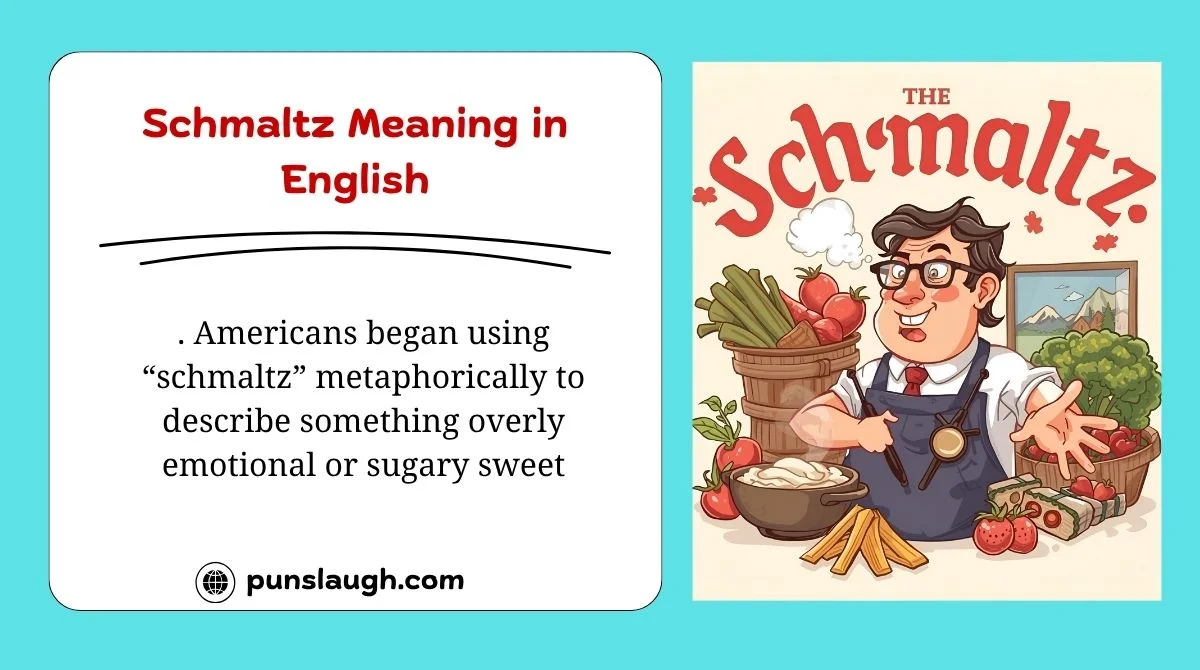Have you ever heard someone say a movie was too schmaltzy or tasted a dish that felt rich with old-world flavor?
That’s schmaltz — a word that carries both taste and emotion. In food, it’s golden chicken fat that gives dishes their unmistakable richness.
In language, it’s an expression for over-the-top sentimentality. Let’s dive into the fascinating world of schmaltz — where flavor meets feeling.
What Does Schmaltz Really Mean?

At its simplest, schmaltz means rendered chicken or goose fat, especially in Jewish and Eastern European cooking. But over time, the word evolved far beyond the kitchen. In English, it’s often used to describe something overly sentimental — like a tear-jerking movie or a love song that drips with emotion.
This duality makes schmaltz unique. One word, two worlds — one rooted in culinary tradition, the other in human feeling.
Schmaltz Meaning in Food
In the culinary world, schmaltz is liquid gold — literally. It’s a flavorful fat created by slowly melting (rendering) chicken or goose skin. Jewish cooks have used schmaltz for centuries to fry, roast, and enrich foods when butter or lard weren’t options due to dietary laws.
Culinary facts about schmaltz:
- Originated in Eastern European Jewish cuisine.
- Common in dishes like matzo balls, latkes, and kasha varnishkes.
- Stored as a solid fat when cooled, but melts beautifully in cooking.
- Adds a deep, savory flavor unmatched by plant oils.
Schmaltz isn’t just about taste — it’s about heritage and resourcefulness, transforming humble chicken fat into something exquisite.
Schmaltz as Chicken Fat

If you’ve ever fried onions in schmaltz, you already know how amazing it smells. Traditionally, Jewish families rendered fat from chicken skins and leftover trimmings, creating a rich cooking fat that defined home-style flavor.
How it’s made:
- Chop chicken skin and fat into small pieces.
- Cook slowly over low heat until golden and the fat melts out.
- Strain and save the liquid fat.
- Bonus: the crispy bits left behind are called gribenes — delicious cracklings often sprinkled on potatoes or bread.
Compared with butter or oil, schmaltz adds an unmatched umami depth. It’s especially prized in savory comfort foods, enhancing everything it touches.
Schmaltz in Vegetarian and Modern Cooking
Interestingly, schmaltz has made a comeback — even in vegetarian and vegan kitchens. Today’s chefs love recreating its flavor without using meat.
Vegan alternatives often mix:
- Coconut oil or sunflower oil for richness.
- Smoked paprika or soy sauce for depth.
- Caramelized onions for aroma.
Some restaurants now feature “vegan schmaltz” — a nod to tradition with a modern twist. This revival shows that schmaltz isn’t just about fat; it’s about comfort, nostalgia, and taste memory.
Schmaltz Meaning in German
In German, the word “Schmalz” (spelled without a “t”) literally means fat, grease, or lard. It’s used in a straightforward, culinary sense — nothing emotional about it.
However, when Yiddish evolved from German dialects among Ashkenazi Jews, the word took on deeper cultural resonance.
In Germany, you can still find “Schweineschmalz” (pork fat) and “Apfelschmaltz” (apple-flavored fat spread). The word simply denotes any rendered fat.
It was Yiddish speakers who gave schmaltz its emotional twist.
Schmaltz Meaning in English

When Jewish immigrants brought schmaltz to America, the word melted right into English — just like the fat it described.
But its meaning changed. Americans began using “schmaltz” metaphorically to describe something overly emotional or sugary sweet.
By the 1930s and 40s, schmaltz was part of pop culture. Radio shows, movies, and critics used it to mock melodrama or sentimental songs. If something made you tear up too much, it was schmaltzy.
Example:
“That movie was pure schmaltz — all tears and violins.”
So, in English, schmaltz means both fat and feelings — a rare word with such delicious duality.
Schmaltz as Slang — The Sentimental Side
When someone calls a speech or song “schmaltzy,” they’re saying it’s dripping with sentiment. The slang sense evolved naturally from Yiddish and became popular in show business, especially in the Hollywood golden era.
Examples of schmaltz in slang:
- “That ad was too schmaltzy for me — all heart, no substance.”
- “He poured on the schmaltz to get the crowd emotional.”
In short, schmaltz is what happens when sincerity turns syrupy. But depending on the context, it can be affectionate or mocking — sometimes both at once.
Schmaltz vs Sentimental — What’s the Difference?
While schmaltz and sentimental overlap, they’re not identical. Schmaltz carries a touch of irony or exaggeration.
| Word | Meaning | Tone | Example |
|---|---|---|---|
| Sentimental | Showing gentle emotion or nostalgia | Neutral to positive | “That song was sweetly sentimental.” |
| Schmaltzy | Excessively emotional, even cheesy | Often humorous or mocking | “That soap opera is pure schmaltz.” |
Key difference:
Sentimental touches your heart.
Schmaltzy tries too hard and makes you aware of it — like emotional icing on a cake.
Etymology and Schmaltz Origin
The linguistic roots of schmaltz trace back to Middle High German “smalz”, meaning to melt or fat/grease.
Yiddish speakers, mainly from Central and Eastern Europe, borrowed and adapted it. As Jewish immigrants moved west, schmaltz traveled with them — from shtetls (villages) to New York delis.
Over time, the word gained emotional flavor — perhaps because food and feeling were inseparable in Jewish culture.
By the 20th century, schmaltz symbolized warmth, nostalgia, and exaggerated emotion — both in cooking and in expression.
Cooking with Schmaltz
Cooking with schmaltz is like cooking with history. It’s aromatic, flavorful, and deeply comforting. From frying onions to roasting potatoes, it gives dishes an old-fashioned richness that modern oils can’t match.
Popular dishes made with schmaltz:
- Matzo Ball Soup — the Jewish classic where schmaltz binds the matzo balls.
- Latkes (Potato Pancakes) — fried in schmaltz for an unbeatable crispness.
- Chopped Liver — blended with schmaltz for creamy texture.
- Roasted Vegetables — carrots, parsnips, and onions tossed in schmaltz.
Pro tip: When cooking, a little schmaltz goes a long way. Its intense flavor makes it perfect for finishing dishes, like buttering toast with soul.
How to Make Schmaltz at Home
You don’t need a chef’s hat — just a few ingredients and patience.
Ingredients:
- Chicken skin and fat (from about 2-3 birds)
- 1 medium onion, diced
- Salt (optional)
Instructions:
- Chop the chicken fat and skin into small pieces.
- Place them in a skillet with a splash of water (prevents burning).
- Cook slowly on low heat until the fat melts and pieces turn golden brown.
- Add onions for extra flavor, then cook until everything’s crisp.
- Strain the liquid fat into a jar.
- Save the crispy bits — they’re gribenes — delicious little snacks.
Storage:
Keep in the refrigerator up to a month, or freeze for longer. It solidifies like butter but melts instantly when heated.
“Rendering schmaltz is an act of preservation — not just of fat, but of memory.”
Derived Meanings and Cultural Significance
Beyond food, schmaltz symbolizes love, nostalgia, and cultural continuity. In Jewish tradition, food often carries meaning — it connects generations and celebrates identity.
In language, schmaltz became a metaphor for emotional richness — sometimes sincere, sometimes exaggerated.
In a way, schmaltz reminds us that both in cooking and life, a little heart goes a long way.
Modern-Day Uses of Schmaltz
In today’s world, schmaltz has reappeared in two exciting ways:
- Culinary Revival — Gourmet chefs embrace schmaltz for its flavor depth. Upscale restaurants use it in sauces, dressings, and roasted dishes.
- Pop Culture Comeback — Writers and critics still use schmaltzy to describe sentimental art, ads, or speeches.
Even on social media, hashtags like #schmaltzlife and #renderedwithlove celebrate both meanings. The word’s dual identity — part flavor, part feeling — makes it timeless.
Health Considerations
Like all animal fats, schmaltz should be enjoyed in moderation. It’s high in monounsaturated fats (the same heart-friendly fats found in olive oil), but also contains saturated fats.
Nutritional snapshot (per tablespoon):
| Component | Amount |
|---|---|
| Calories | 115 kcal |
| Fat | 12.8 g |
| Saturated Fat | 4 g |
| Monounsaturated Fat | 6 g |
| Polyunsaturated Fat | 2 g |
| Cholesterol | 25 mg |
Health insights:
- When used sparingly, schmaltz can be part of a balanced diet.
- Avoid overheating it; use low to medium heat to preserve nutrients.
- It’s a natural, unprocessed fat — unlike hydrogenated oils.
So, schmaltz isn’t the villain many assume. As with most indulgences, it’s all about moderation.
Schmaltz in Different Contexts — Comparison Table
| Context | Meaning | Example | Tone | Usage |
|---|---|---|---|---|
| Culinary | Rendered chicken/goose fat | “Use schmaltz instead of butter for flavor.” | Neutral | Food, recipes |
| Linguistic | Excessive sentimentality | “That speech was dripping with schmaltz.” | Humorous | Reviews, art, media |
| Cultural | Nostalgia or emotional warmth | “The festival was pure schmaltz — and everyone loved it.” | Warm, nostalgic | Cultural events |
Schmaltz Example Sentences
To understand the word in real use, here are some examples:
- “She added a spoonful of schmaltz to the soup for richness.”
- “His toast at the wedding was pure schmaltz, but it made everyone smile.”
- “Critics called the film schmaltzy, yet audiences adored it.”
- “You can’t cook traditional matzo balls without schmaltz.”
Each sentence captures a side of the word — flavorful or emotional.
Schmaltz Pronunciation Guide
| Language | Pronunciation | IPA | Notes |
|---|---|---|---|
| English | shmaltz | /ʃmɔːlts/ | Rhymes with “waltz” |
| German | schmalz | /ʃmalts/ | Short “a,” sharper “ts” sound |
Tip: Say it with a little Yiddish flair — “shmaltz” with that soft, rolling “sh” sound.
Related Words and Phrases (See Also)
- Lard — rendered pork fat
- Tallow — beef or mutton fat
- Butterfat — milk-derived fat
- Grease — general term for oily substance
- Sentimental, Corny, Sappy — English analogues to “schmaltzy”
These words help show how schmaltz fits into the broader world of food and feeling.
FAQs About Schmaltz Meaning
What exactly is schmaltz made of?
Schmaltz is made from rendered chicken or goose fat, often cooked slowly with onions until golden. It’s strained and used as a flavorful cooking fat.
Is schmaltz healthy or unhealthy?
It’s high in calories but contains both healthy and saturated fats. When eaten in moderation, it can be part of a balanced diet.
Can vegetarians eat schmaltz?
Traditional schmaltz is animal-based, but vegan schmaltz versions use plant oils and spices to recreate the flavor.
Why is schmaltz used as slang for sentimentality?
Because it’s rich, heavy, and indulgent — much like exaggerated emotions. The metaphor caught on in entertainment circles and remains popular today.
How long does homemade schmaltz last?
Stored in an airtight container, schmaltz lasts up to 4 weeks in the fridge or 6 months in the freezer.
Final Thoughts
Schmaltz is more than fat — it’s flavor, history, and heart. From old Jewish kitchens to modern restaurants, from comfort food to cultural slang, this humble word bridges the gap between taste and emotion.
So next time you hear someone say something’s “a bit schmaltzy,” smile — because schmaltz, whether in food or feeling, reminds us that a touch of richness makes life more beautiful.





